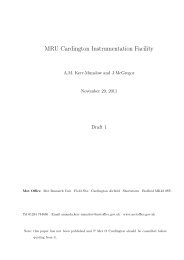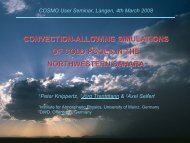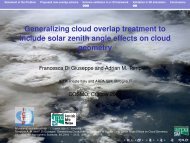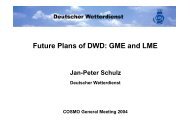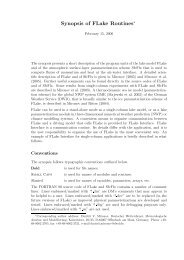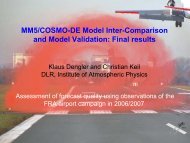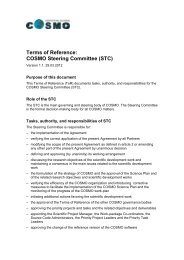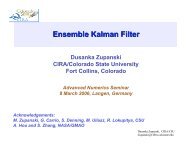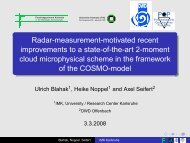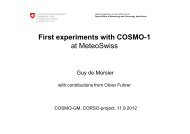document - Cosmo
document - Cosmo
document - Cosmo
You also want an ePaper? Increase the reach of your titles
YUMPU automatically turns print PDFs into web optimized ePapers that Google loves.
1 Working Group on Data Assimilation 29<br />
m/s<br />
7<br />
6<br />
5<br />
4<br />
3<br />
2<br />
1<br />
0<br />
-1<br />
-2<br />
Extrema of W<br />
-3<br />
0 20 40 60 80 100 120 140 160 180 200 220 240 260 280 300 320 340 360<br />
time (min)<br />
Figure 4: Panel a): Time evolution of the maximum up- and downdraft ( m/s) during<br />
the assimilation experiment in conditions conducive to anomalous propagation of the<br />
radar beam. Positive values denote updrafts, negative values downdrafts. The forcing<br />
is applied during 4 hours. Panel b): Vertical cross-section through maximum updraft<br />
of the anaprop experiment at 2h into simulation time. Displayed are RH (in %,<br />
shaded), potential temperature (2K contour interval, thin lines) and vertical velocity<br />
(0.5 m/s contour interval, bold lines, solid updrafts, dashed downdrafts).<br />
4 Summary and discussion<br />
In this study the sensitivity of the Latent Heat Nudging (LHN) scheme to non-rain echoes<br />
was investigated by means of idealised experimentation with synthetic and real radar data.<br />
It constitutes one part of an effort to judge the LHN’s aptness as an efficient and economic<br />
scheme for operational high-resolution rainfall assimilation. The main findings of this study<br />
are:<br />
• non-rain, or clutter, echoes as small as one pixel can trigger the release of convective<br />
instabilities when forced by the LHN scheme;<br />
• the resulting precipitation can be large compared to the original signal, i.e. factors 3<br />
up to 50 have been found for moderate to high value of CAPE;<br />
• the response of the model atmosphere to the forcing is very quick, i.e. on the time<br />
scale of convection (less than ten minutes for strong forcing to a couple of hours for<br />
moderate forcing);<br />
• large, coherent areas of non-rain echoes pose a more stringent problem;<br />
• filtering the input data can significantly mitigate the problem;<br />
• non-rain echoes resulting from anomalous propagation of the radar beam in a lowstratus<br />
case over Switzerland, by virtue of the usually stable and dry conditions associated,<br />
are not conducive to error amplification. However, a strong spurious vertical<br />
circulation, along with undesired mixing, may be induced and adversely impact the<br />
mesoscale circulation.<br />
A limitation of the study is that the impact of non-rain echoes is investigated in isolation.<br />
The negative impact found may be less dramatic in situations, when clutter is embedded in<br />
COSMO Newsletter No. 6<br />
330<br />
324<br />
318<br />
312<br />
306<br />
300<br />
294<br />
288<br />
330<br />
324<br />
318<br />
312<br />
306<br />
300<br />
294<br />
288<br />
330<br />
324<br />
318<br />
312<br />
306<br />
300<br />
294<br />
288




